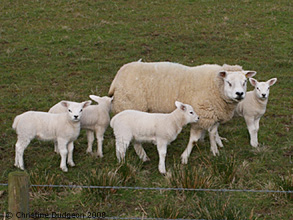Notes On Nematodirus
5 April 2017 Infection with Nematodirus battus causes scour and death in lambs during late spring and early summer. Losses can be high and surviving lambs suffer a check in growth. Lambs aged 6 to 12 weeks are most often affected. The worms live in the intestines and eggs are passed in the dung.
Infection with Nematodirus battus causes scour and death in lambs during late spring and early summer. Losses can be high and surviving lambs suffer a check in growth. Lambs aged 6 to 12 weeks are most often affected. The worms live in the intestines and eggs are passed in the dung.
Nematodirus Eggs
Nematodirus eggs like a period of cold weather followed by rising temperatures in order to hatch. This means that most eggs passed by lambs in spring will not hatch until the following spring. When conditions are right this strategy allows large numbers of eggs to hatch at the same time posing a serious risk of disease. Hatching dates vary with region and a disease forecasting map can be found at www.scops.org.uk.
Nematodirus eggs are capable of surviving for 2 years in soil. Fields where lambs have scoured due to nematodirus will be contaminated with high numbers of eggs and should ideally not be used for young lambs the following year. Avoiding grazing lambs on the same fields every spring will reduce the risk of nematodirus outbreaks by preventing a year on year build up of eggs.
Symptoms
Affected lambs look tucked up, don’t suck, have a severe scour and may be found gathered around water troughs. Nematodirus eggs can be found in dung samples but scour and death can occur before any eggs are passed. Diagnosis in these cases requires postmortem examination at your local SAC Veterinary Laboratory.
Treatment
Where there is a nematodirus risk lambs can be dosed two or three times to try and prevent an outbreak. This should be timed based on local knowledge. For example in Scotland nematodirus outbreaks are seen most commonly from mid May to mid June. Despite one report of resistance, white drenches (1-BZ, benzimidazole products) are the treatment of choice in most cases. Not all wormers are suitable for treating Nematodirus so if you are unsure ask for advice on which product to use.
Nematodirus is a difficult worm to kill and drenching must be carried out accurately to avoid underdosing. If lambs are scouring and don’t improve after treatment collect dung samples so that the problem can be investigated. Infection with coccidiosis can cause problems in the same age group of lambs.
Heather Stevenson, heather.stevenson@sac.co.uk
Sign up to the FAS newsletter
Receive updates on news, events and publications from Scotland’s Farm Advisory Service
